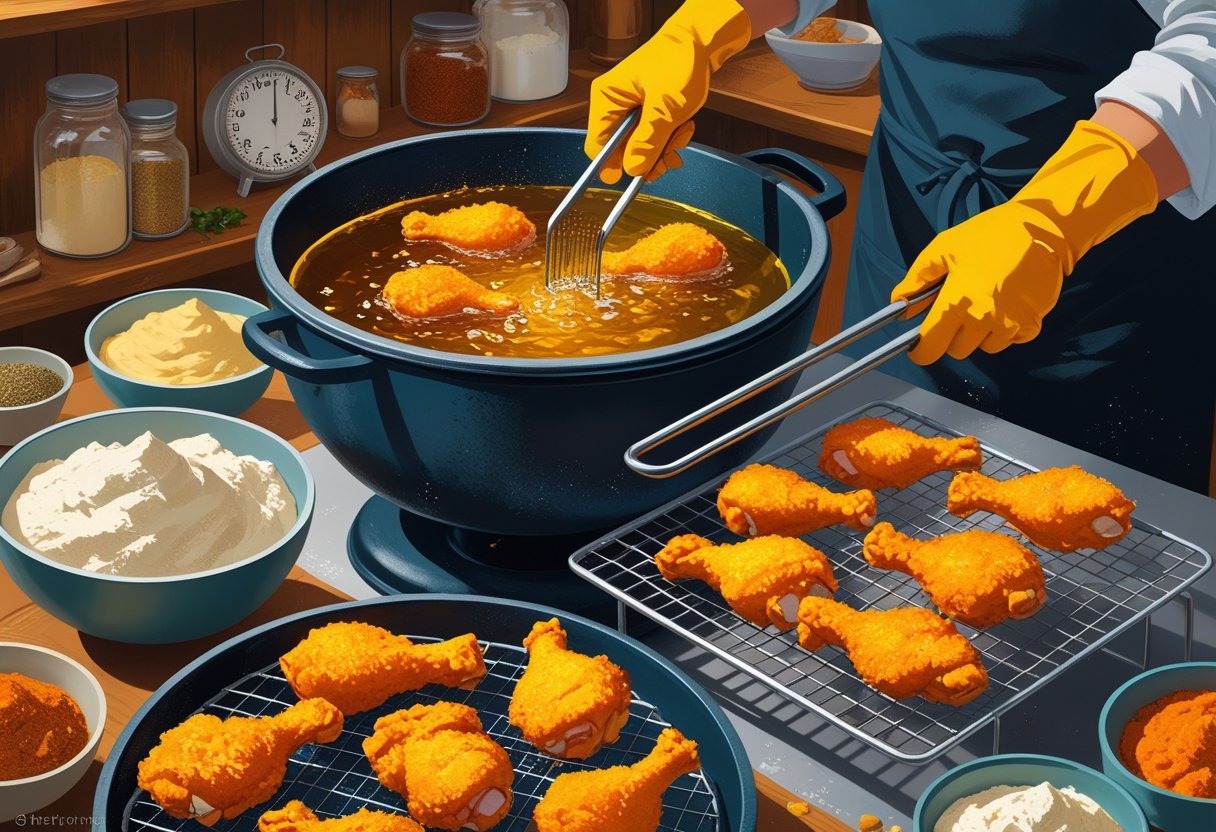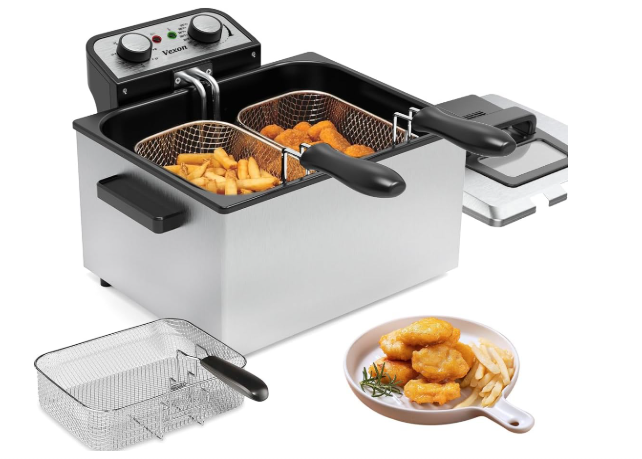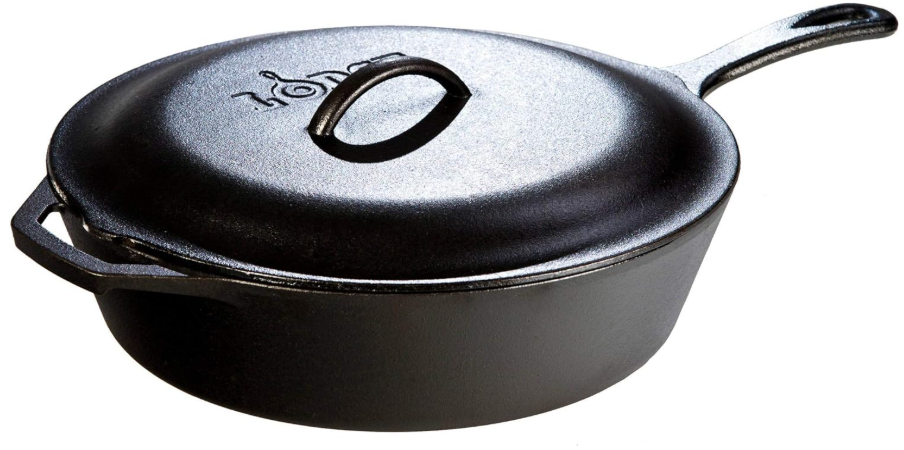Southern deep-frying is a method that transforms simple ingredients into crispy, flavorful dishes. It’s all about frying food in hot oil at just the right temperature, so you get that golden crust and a tender inside.

The real trick to Southern deep-frying? Keeping a steady oil temperature and using a good batter or breading. That’s how you get crunch without greasiness. When you nail it, you end up with food that’s crispy outside, juicy inside.
Learning these basics opens the door to classic Southern favorites—think fried chicken, catfish, hushpuppies. This guide breaks things down so you can chase that perfect crunch at home.
Core Techniques for Deep-Frying Success
Deep-frying needs specific gear, the right oil, and careful control over temperature and time. Getting these right makes all the difference for a crispy texture without the dreaded grease overload.
Essential Equipment and Tools
You’ll want a heavy pot or deep fryer—Dutch ovens and cast iron pots are favorites because they hold heat well.
A thermometer’s a must for checking oil temperature. It’s the only real way to know you’re in the right zone.
Use a slotted spoon or wire basket to get food out safely, and paper towels help soak up extra oil after frying.
Heat-resistant gloves are smart to have, in case of splatters. And a timer, or just your phone, keeps you from overcooking things.
Available form Amazon
Choosing the Right Oils
Pick oils with a high smoke point—like peanut, canola, vegetable, or sunflower. They can handle the heat without burning.
Neutral flavors are best, so the food tastes like itself. Skip olive oil; it just doesn’t work for deep-frying.
Fresh oil gives better flavor. If you reuse oil, strain it and store it right to avoid weird aftertastes.
Smoke Points of Common Oils:
| Oil Type | Smoke Point (°F) |
|---|---|
| Peanut Oil | 450 |
| Canola Oil | 400 |
| Vegetable Oil | 400-450 |
| Sunflower Oil | 440 |
Optimal Temperatures and Timing
Keep oil between 350°F and 375°F. Cooler than that, food soaks up oil and turns greasy. Too hot, and you’ll burn the outside before the inside’s cooked.
Use a thermometer—guessing doesn’t cut it. Fry in small batches to keep the oil hot and steady.
Cooking times depend on the size of what you’re frying—usually 2 to 6 minutes. Bigger pieces need longer, but don’t walk away.
Once fried, let food rest on paper towels right away to get rid of extra oil.
Preparing Ingredients for Southern Crunch
Picking the right ingredients and prepping them well makes a big difference. Good proteins, fresh veggies, tasty marinades, and the right coatings all come together for that signature crunch.
Selecting Quality Proteins and Vegetables
Go for chicken thighs, catfish fillets, or pork chops—these cuts stay juicy thanks to their fat and natural moisture. Freshness matters; look for firm, clean-smelling meat.
For veggies, okra, green tomatoes, and zucchini are classics. Pick ones that are ripe but still firm. Slice them evenly so they cook at the same rate and get a nice crunch.
Classic Marinades and Seasonings
Marinating brings both flavor and moisture. Buttermilk is a go-to for chicken; it tenderizes and adds a subtle tang. Salt, pepper, garlic powder, and paprika are a solid base for seasoning.
Vegetables benefit from a quick soak in salted water or a splash of vinegar. Season your coating with cayenne, black pepper, and garlic powder for that bold Southern kick.
Coating Methods: Batters vs. Breading
Batter’s a wet mix—usually flour, cornmeal, and something like milk, buttermilk, or beer. It gives a thick, crunchy shell and sticks well to moist foods. Great for catfish or green tomatoes.
Breading uses a dry layer—think seasoned flour, breadcrumbs, or cornmeal. You dip the food in egg or buttermilk first. This gives a lighter crunch and works for lean proteins like chicken breast.
| Coating Type | Texture | Best For | Example Ingredients |
|---|---|---|---|
| Batter | Thick and crispy | Moist proteins, veg | Flour, cornmeal, buttermilk |
| Breading | Light and crunchy | Lean meats, veg | Flour, cornmeal, eggs, spices |
Mastering the Frying Process
Frying takes attention—temperature, timing, and preparation all matter. Get these right, and you’ll have food that’s crispy and evenly cooked, not oily.
Step-By-Step Frying Instructions
Start by heating the oil to 350°F (175°C). Don’t skip the thermometer. Coat your food with batter or breading right before frying.
Lower food into the oil gently to avoid splashes. Don’t crowd the pan—too much at once cools the oil down.
Fry until golden brown, usually 3-6 minutes depending on what you’re making. Use a slotted spoon to lift it out and drain on paper towels.
Tips For Achieving Even Golden Color
Stick to a steady oil temperature. If it’s too hot, the outside burns before the inside’s done. Too cool, and you get greasy, pale food.
Pat food dry before frying to avoid splattering and uneven cooking. Turn pieces halfway through for even browning.
Pick an oil with a high smoke point, like peanut or vegetable oil. These hold up better and help get that clear, golden crust.
Serving and Enjoying Southern Fried Food
How you serve fried food matters for keeping it crispy and tasty. Presentation shows off that golden color and texture. The right sauces and sides make the meal way more interesting.
Proper Draining and Presentation
After frying, let food drain on a wire rack or paper towels. This keeps the coating crisp instead of soggy.
Arrange food with space between pieces—don’t pile it up, or you’ll lose that crunch.
Warm plates help food stay hot longer. Nobody wants cold, soggy fried chicken, right?
Traditional Southern Sauces and Sides
Classic southern sauces like honey mustard, ranch, hot sauce, and comeback sauce each bring their own twist to fried food. Some are creamy, some have a kick—there’s always something for everyone.
When it comes to sides, you’ll usually see collard greens, coleslaw, baked beans, and mashed potatoes. They give you a mix of textures and keep things interesting on the plate.
Pickles or a lemon wedge? Those little extras can really brighten up the whole meal, cutting through all that richness with a sharp, tangy bite.
NOTICE: Our website contains affiliate links. This means if you click and make a purchase, we may receive a small commission. Don’t worry, there’s no extra cost to you. It’s a simple way you can support our mission to bring you quality content.



